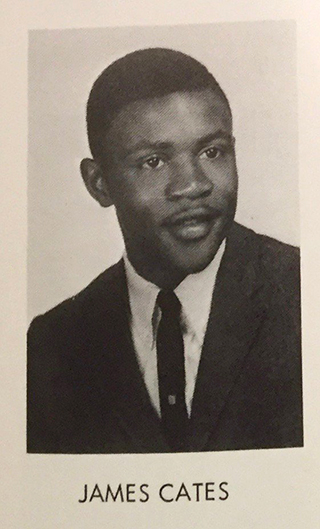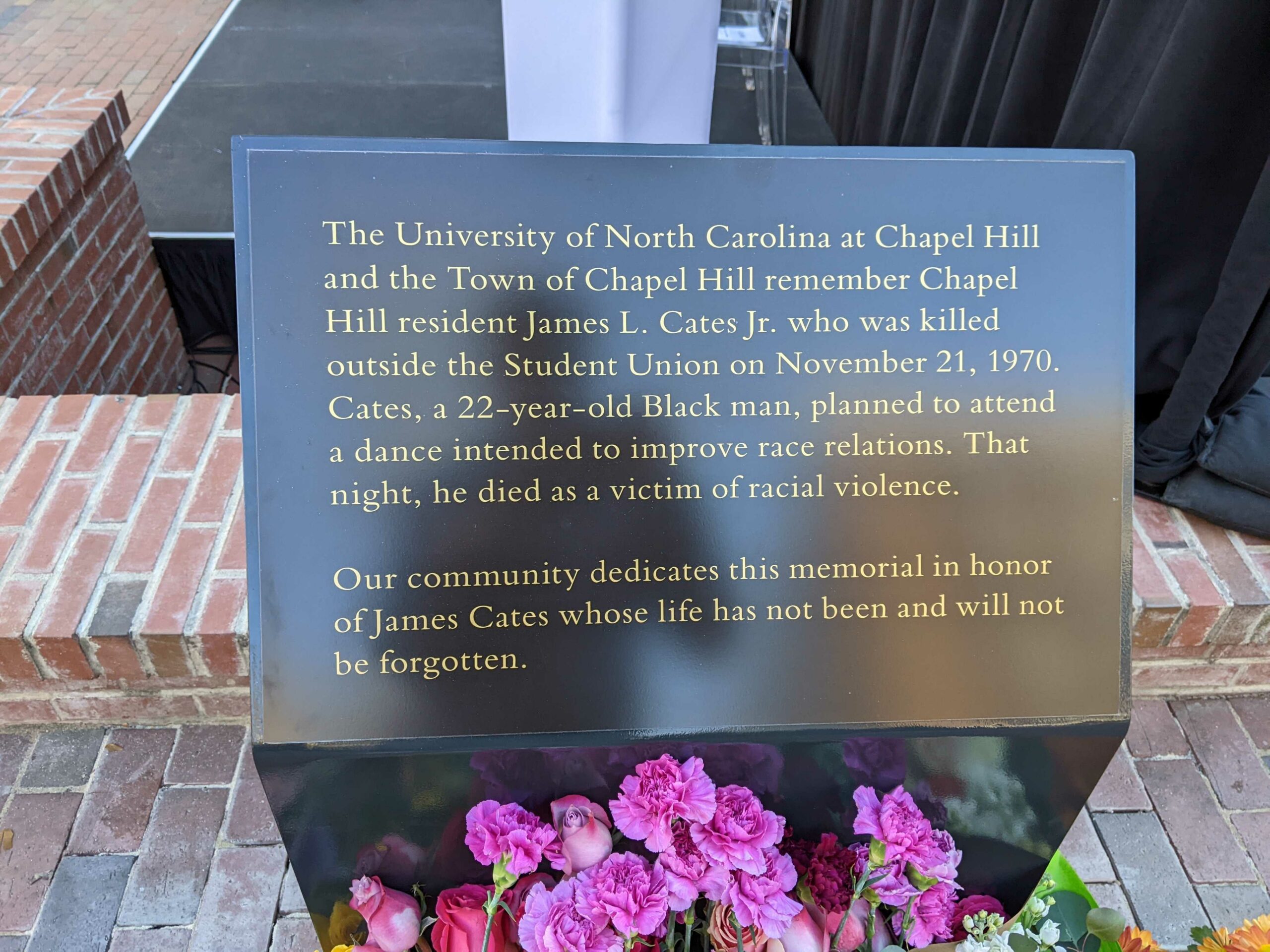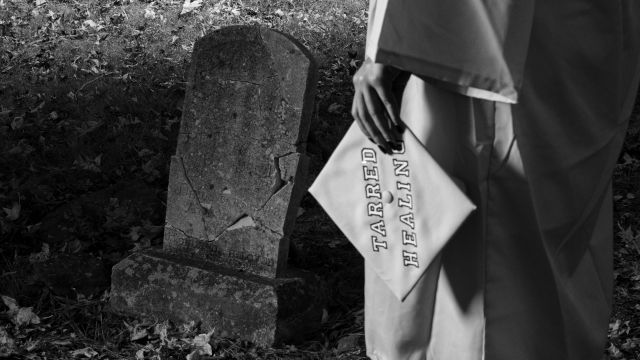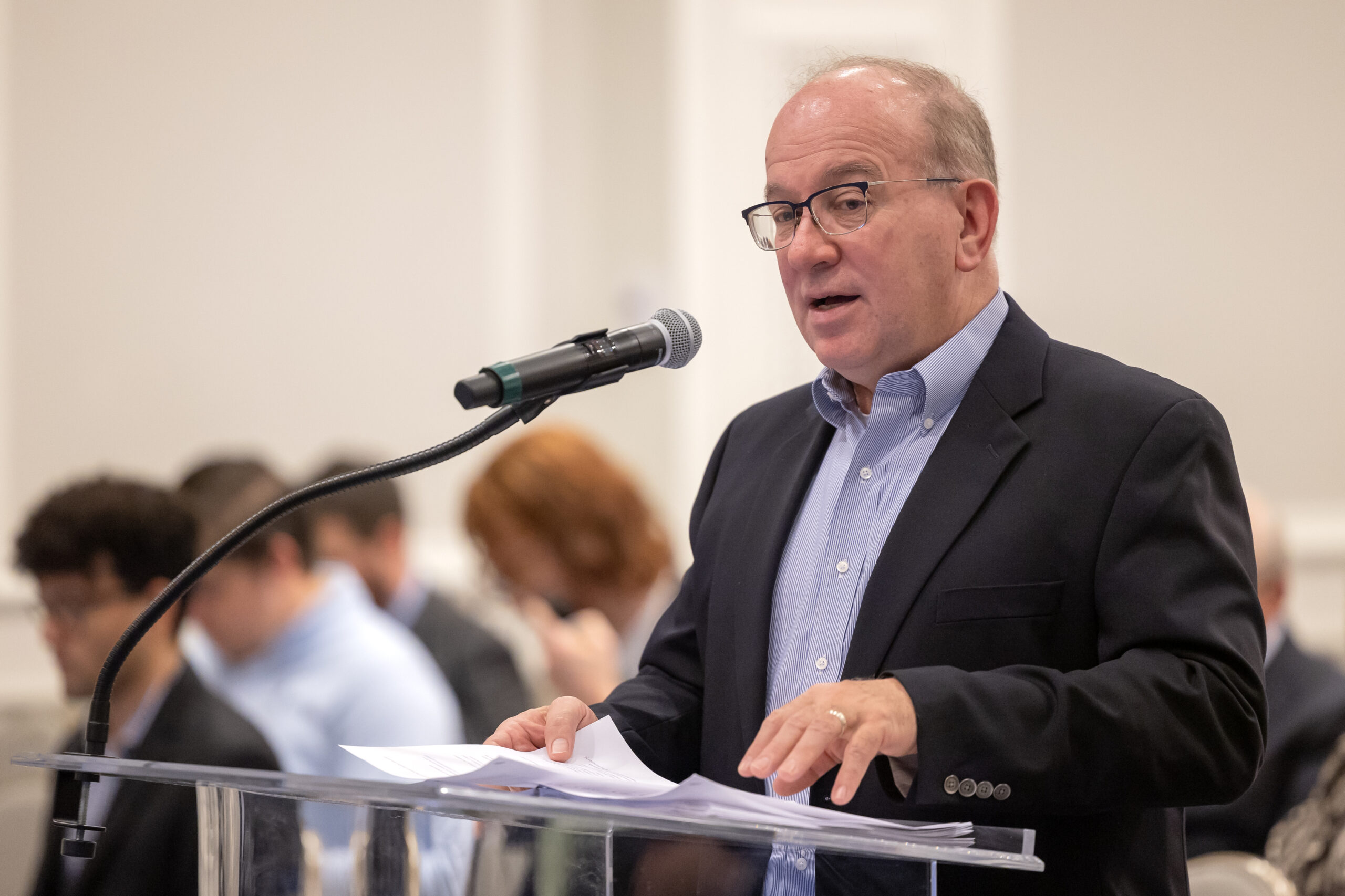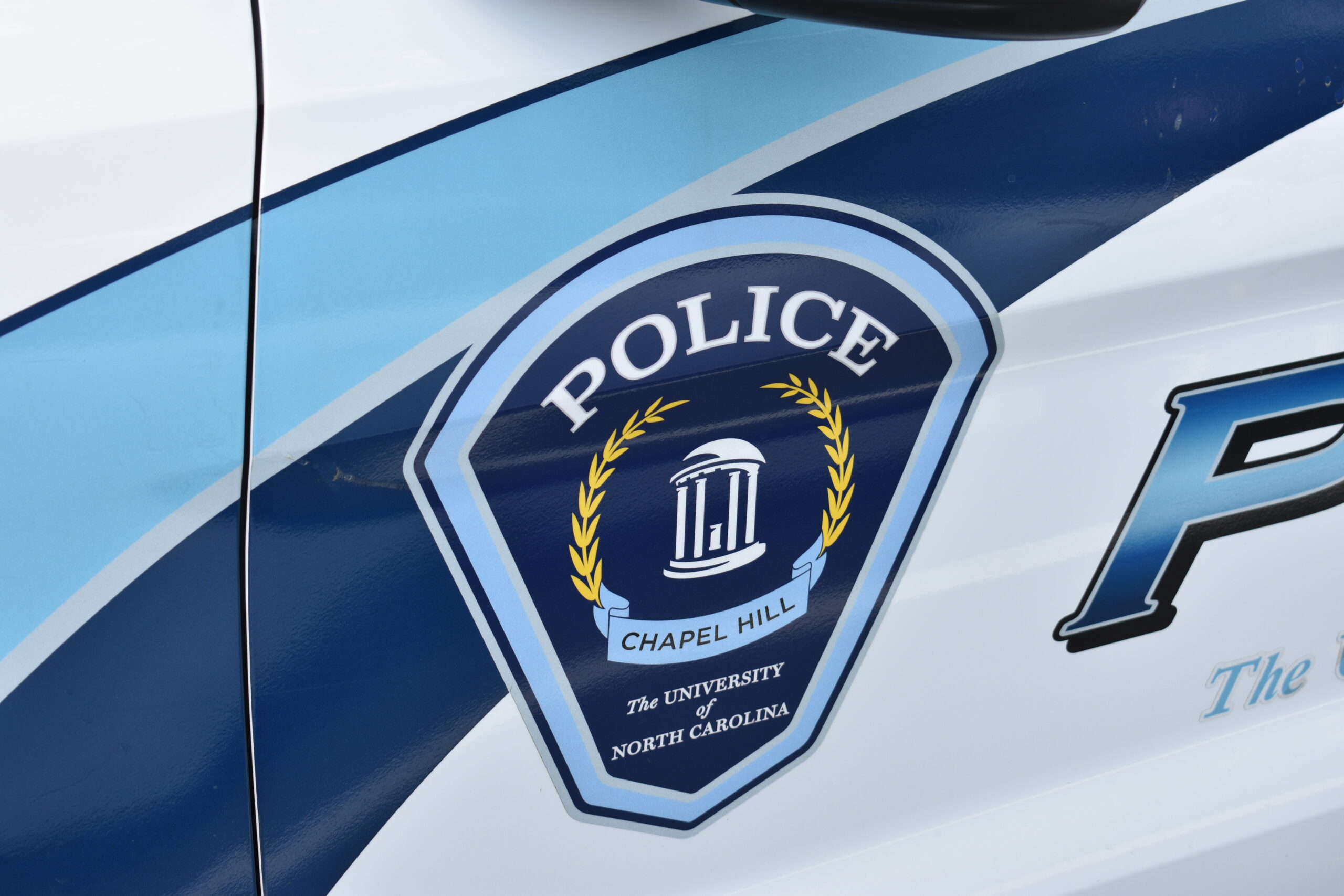Monday marked the anniversary of a tragedy among the Chapel Hill community. 22-year-old James Cates Jr. was murdered on UNC’s campus in 1970, with his death starting of decades of Black residents calling to remember him and ask for justice.
This year, though, was slightly different. While his murder still goes unresolved, UNC unveiled a historical marker memorializing Cates and taking a step toward reckoning with a local history of racial injustice.
Hundreds of people gathered around the Pit, the brick area at the center of a key campus area. Surrounded by the student union, Student Stores building, the undergraduate library and main dining hall, the area had a new addition to it on Monday night: a sleek, black plaque describing what happened to Cates. Not far from that spot, 52 years prior, the Black Chapel Hill resident was stabbed outside the Carolina Student Union, where an all-night dance was held to help Black and white students and young community members interact. Members of the Storm Troopers motorcycle gang, who had ties to white supremacy, attacked Cates and knifed him twice. The 22-year-old was left near the Pit and ultimately died from his injuries after a lack of medical attention from first responders.
UNC’s Board of Trustees approved a marker to honor Cates earlier this year, but the university lacked a broader effort to recognize the Chapel Hill resident until recently. Historical reports reflect how UNC leadership in 1970 largely disregarded accounts from Black residents about Cates’ murder during an internal review. Student and community efforts in the years since to recognize Cates with a building name and with their own memorials were met with inaction or removal of those markers.
Danita Mason-Hogans, a Chapel Hill native and local historian, has served on the James Cates Remembrance Coalition for the Town of Chapel Hill. On Monday, she said she was encouraged to see collaboration between the university, local government and Cates family come to fruition after so many years.
“I really hope that it’s a pivot and a nod to really [understanding] where we come from as a community, what really have transpired here, and start on the reparative path,” said Mason-Hogans. “We all want reconciliation, but until we have truth, there can be no reconciliation. This is an acknowledgement of the truth, and a direction toward [that], and so I’m grateful for that.”
While the memory and story of Cates may have faded over the decades for UNC community members, Mason-Hogans said many Black Chapel Hill residents passed on the injustice done against the man nicknamed “Baby Boy.”
“The Black women who mourned for him during that time,” Mason-Hogans described, “they’re the ones, along with the rest of the community, who has kept Mr. Cates’ memory to mind.”
UNC Student Body President Taliajah Vann said once she learned about Cates’ murder and his family’s efforts for recognition, she couldn’t help but think of the 22-year-old when she visited where he died.
“I don’t know how to describe the sadness you feel walking through the Pit, before we had this memorial, and knowing what happened,” said Vann. “Knowing there is no memorial, there is no marker, there is no conversation about it publicly, because our university has chosen to not value the history. To not be honest and accountable in that way. It [was] really heartbreaking.”
The student body president said she believes UNC and the Town of Chapel Hill are obligated to collaborate and recognize the full, diverse history the institutions hold. By doing so with the memorial marker, Vann said the groups are shouldering some of the responsibility of telling Cates’ tragic story to many more people who ought to know – including UNC’s Black community.
“Now, amongst all of the things this memorial does,” she said, “it will be an opportunity for Black students to get what they deserve: access to their history where they don’t have to dig through a book or an article from 50 years ago. You don’t have to only get the benefit of knowing what happened because someone else passed that information along to you.”
Nate Davis Jr. is the son of the man, Nathanial Davis Sr., who held Cates as his life slowly ended five decades ago. The younger Davis said he only fully learned about Cates’ story in recent years and the moment sparked a life of activism by his father. He said Monday he hopes the memorial plaque will spark something in those who now walk by too.
“I hope they will think that this university tried to get it right,” Davis said of UNC’s recent efforts to install a marker. “That his life is still speaking, his life still lives on through this commemoration. So, I hope that’s what they see, and that they’re able to walk through this place in freedom.”
UNC Chancellor Kevin Guskiewicz read the memorial’s inscription and delivered the university’s dedication during Monday’s ceremony. He also said while he believes this was an important step to take, UNC is not finished trying to address, teach and learn from its past.
“Our job as a university is to shine a light on the truth, even when that truth is painful,” said Guskiewicz. “We have a long, 229-year history as a university and each of us has a role to play — a role to play in what is often times a complex history. But it’s equally important, and perhaps more important, to be looking forward toward the university’s future. And that is also what today is about.”
Valerie Foushee, a Chapel Hill native and U.S. Representative-elect for the district, delivered remarks representing the Cates family on Monday. She said the group is grateful for the insurance the tragedy is cemented in UNC and Chapel Hill’s local history, agreeing with the chancellor that it marks a new “season.” She said it could be a turning point for the university as it continues to grapple with equity and inclusion – both historically and currently.
“We, in this moment, have the ability to begin to shape and determine what this community can be,” said Foushee. “This memorial can inform and influence how we unify as a community around a common goal of acceptance and inclusivity, a beloved community where all are respected and welcomed.”
“Only by adequately acknowledging our history can we begin to reckon with it,” the future Congresswoman added. “And only by reckoning can we reconcile. And with that reconciliation, we should vow to do better. Because we now know better and, indeed, we can be better.”
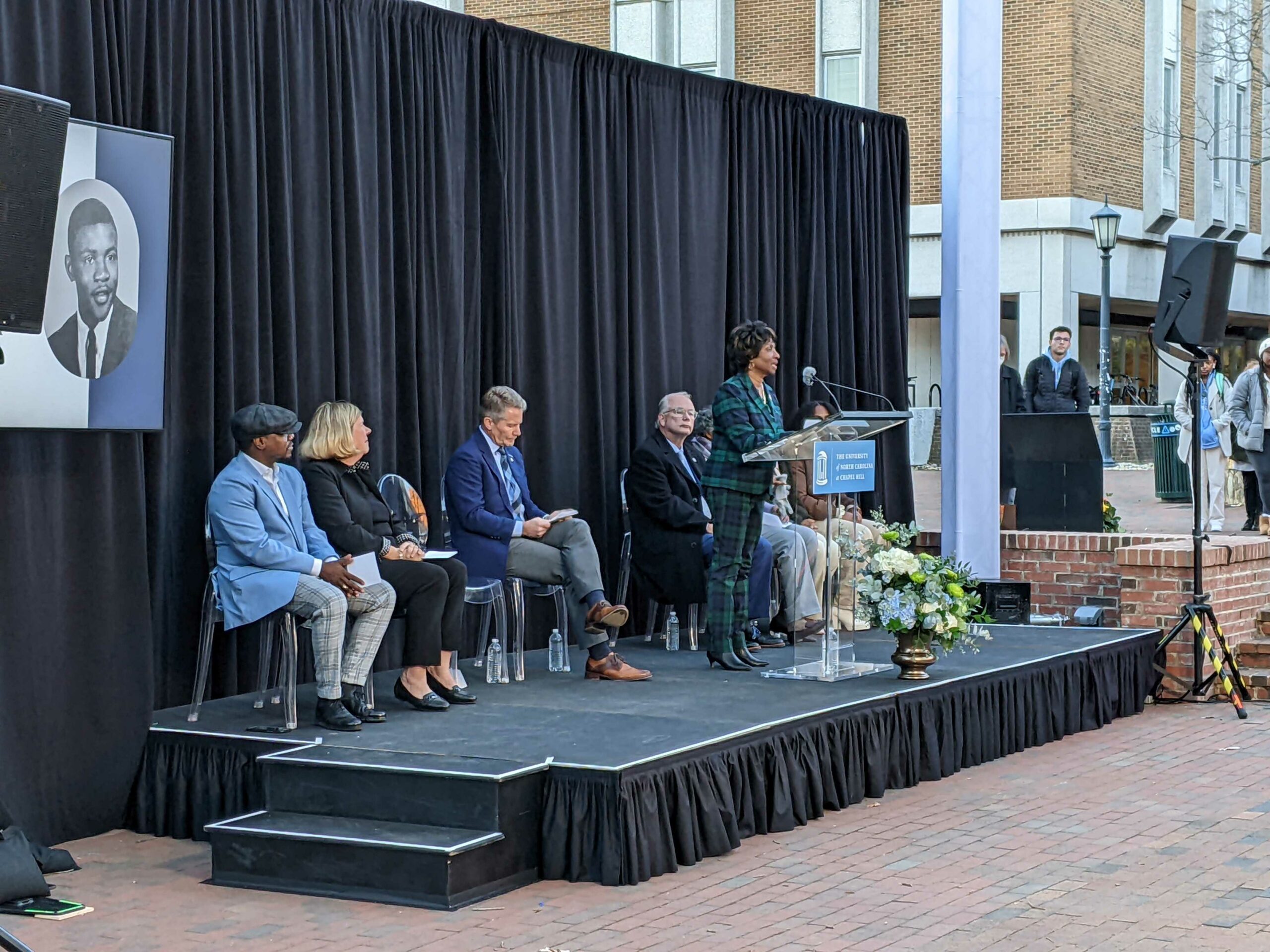
Congresswoman-elect Valerie Foushee speaks as a representative of the Cates family during UNC’s memorial dedication ceremony. On stage with her, from left to right: Pastor Nate Davis Jr., Chapel Hill Mayor Pam Hemminger, UNC Chancellor Kevin Guskiewicz, UNC Board of Trustee David Boliek, Vice Provost for Equity and Inclusion Leah Cox, UNC Student Body President Taliajah Vann, and UNC Black Student Movement President Julia Clark.
Chapelboro.com does not charge subscription fees, and you can directly support our efforts in local journalism here. Want more of what you see on Chapelboro? Let us bring free local news and community information to you by signing up for our biweekly newsletter.


